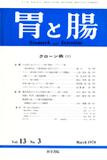Japanese
English
- 有料閲覧
- Abstract 文献概要
- 1ページ目 Look Inside
- サイト内被引用 Cited by
クローン病は腸の炎症疾患の中で,原因不明の代表的なものである.このため病理形態学的にも絶対的な診断基準はなく,現状では種々の病理形態学的所見を総合して診断されている.Crohnらが1932年に初めて一つの独立疾患として報告して以来,クローン病の病理形態の特徴的所見は多くの先達によって挙げられてきた3)9)12)13)15)~18)26)30).しかし,個々の病理組織所見は他の腸炎疾患にも見られるものであり,またときには特徴的病理組織像に乏しいために,病理形態学的にクローン病と診断できないことがある.
炎症疾患は固定した状態にはなく,種々の過程を経るものであり,特に腸管においては二次感染などにより,ますます複雑な病理形態像を示す.さらに治療によっても同様の現象が見られる.したがって,病変の正確な診断は臨床症状,X線や内視鏡検査,病理組織学的検索などを組合せた総合的視野から行うべきことは当然である.また炎症疾患を病理形態学的に診断しようとする場合でも,われわれはいかなる時期の病変や病変部位を検索しているかを常に念頭に置く必要がある.
The pathomorphological criteria for intestinal Crohn's disease which have hitherto been mentioned by many other investigators were reevaluated using 21 definite and three probable cases of Crohn's disease. The criteria consists of both macroscopic and microscopic characteristics; (1) segmental or discontinuous disease pattern (skip lesion), (2) longitudinal ulcer, cobblestone appearance and/or dense inflammatory polyposis, (3) fissuring ulcer (and fistula), (4) noncaseating epithelioid granuloma without acid-fast bacilli, and (5) transmural inflammation with an aggregated pattern.
Definite Crohn's disease was defined as fulfilling all characteristics above-mentioned except for fissuring ulcer, and probable one as lacking in granuloma alone, or granuloma and transmural inflammation.
Longitudinal ulcer more than about 5 cm in length along the mesenteric side was observed only in the small intestine and occurred in nine of ten first resected specimens of the small intestine. Cobblestone appearance of the mucosa was seen in both small and large intestines. Only three of 21 cases showed a cobblestone appearance all over the affected lesion and three had a mixed pattern of inflammatory polyposis and cobblestone appearance. On the other hand, six other cases had cobblestoning mucosas various in number around a longitudinal ulcer. Dense inflammatory polyposis was seen only in the large intestine and occurred in 11 of I4 cases with colonic lesion. They were also observed scattered in a few number in the small intestine.
Cobblestone appearance of the mucosa was produced by small reticular ulcers, fissuring ulcers and their sinus tracts in the submucosa as dense inflammatory polyposis. There were no essential differences between cobblestoning mucosa and inflammatory polyp ; the latter was smaller, taller and abruptly elevated, whereas the former was larger and domeshaped.
Atypical forms of ulcer such as round, oval, circular or semicircular pattern were seen in the small intestine of recurrent cases with severe stricture at the anastomosis which may cause distortion and obliteration of lymphatic channels for granulomas to occur along those.
The most important characteristics of histopathologic findings were non-caseating granulomas and transmural inflammation with an aggregated pattern. Granulomas were various in size, and in amount of epithelioid cells, and were most numerous in lymphoid aggregates. However, they markedly decreased in number in the areas of ulceration, secondary infection and fibrosis as well as in an autopsy case died of malabsorption syndrome in Crohn's disease. As a very rare phenomenon, central coagulation necrosis was detected in each only one granuloma in two cases.
Spontaneous healing of ulcer was conspicuous in four cases of colonic Crohn's disease. It was found in almost half of the colonic lesion in three cases and in almost entire lesion in one. On the contrary, it was very sparse in the small intestine. There was no histologic effect of steroid on granulomas and ulcers in two cases. In one probable case of Crohn's disease, however, a 25 cm longitudinal open ulcer was healed with hyperalimentation and the ulcer was replaced by fibrosis and regenerative epithelia without any trace of granulomas. Dense inflammatory polyposis seems to be typical of colonic Crohn's disease, whereas longitudinal ulcer typical of Crohn's disease of the small intestine. Such longitudinal ulcer, however, was rarely observed in cases of ischemic lesions of small and large intestines. Therefore, they should be moreover investigated from a standpoint of histopathology as well as clinical data.
Low incidence of colonic Crohn's disease is probably attributable to high incidence of spontaneous healing of its ulcer. Probable cases in our data may be submitted as a case of Crohn's disease because of no histologic evidence of ischemic lesion and because of disappearance of granulomas by exteranl and internal factors.

Copyright © 1978, Igaku-Shoin Ltd. All rights reserved.


